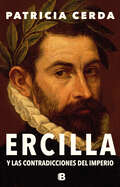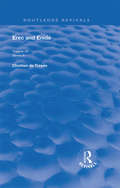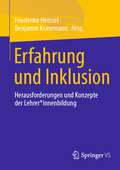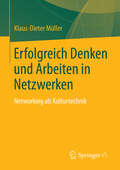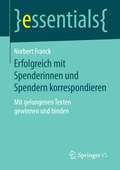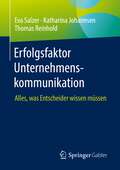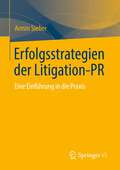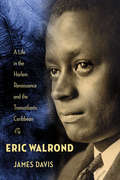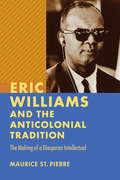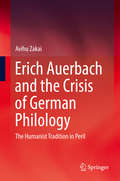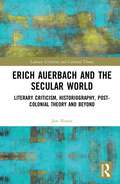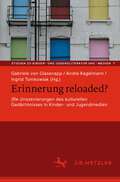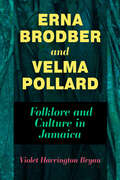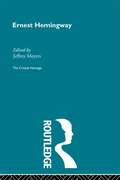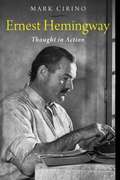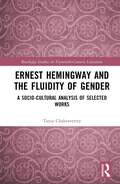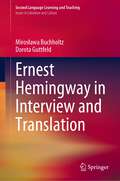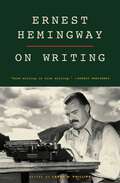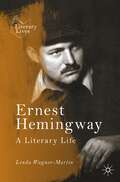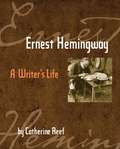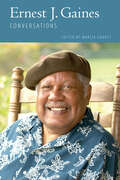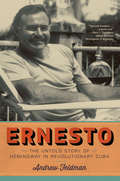- Table View
- List View
Ercilla y las contradicciones del imperio
by Patricia Cerda PincheiraPatricia Cerda, una de las más importantes exponentes de la novela histórica chilena, reconstruye la historia del poeta soldado Alonso de Ercilla, autor de La Araucana. Ercilla y las contradicciones del imperio narra los periplos de un autor tan adelantado como talentoso, testigo privilegiado de la conquista española y los abusos que sus compatriotas ejercieron sobre los nativos, en nombre de Dios y la Corona. Pero es, sobre todo, una exploración del proceso que llevó a Alonso de Ercilla a escribir La Araucana, el poema épico fundacional de una patria ajena que el español hizo propia. A través de una investigación exhaustiva, y valiéndose de una pluma osada y madura, la historiadora y novelista Patricia Cerda reconstruye la trayectoria de una figura central no solo de la literatura hispanoamericana, sino también de la historia de Chile. Autora del super ventas Mestiza y de otras exitosas ficciones históricas, en su séptima novela propone un viaje al centro de la guerra de Arauco y la revisión del origen de un país, contradictorio y turbulento.
Erec and Enide (Routledge Revivals)
by Chretien de TroyesPublished in 1987: Erec and Enide, the first of five surviving Arthurian romantic poems by a twelfth-century French poet, narrates a vivid chapter from the legend of King Arthur.
Erfahrung und Inklusion: Herausforderungen und Konzepte der Lehrer*innenbildung
by Friederike Heinzel Benjamin KrasemannIn Bezug auf Inklusion steht die Lehrer*innenbildung vor der Herausforderung, dass im deutschen Schulsystem Inklusion bisher unzureichend realisiert wurde und dass die Erfahrbarkeit erfolgreicher Inklusion in dieser schulischen Wirklichkeit mit ihren inklusionsfremden Selektionsmechanismen für Lehramtsstudierende und Lehrpersonen stark eingeschränkt erscheint.Im vorliegenden Band wird dieses Spannungsverhältnis in Form unterschiedlicher Herausforderungen thematisiert, die entstehen, wenn erlebte schulische Praxis und Resultate wissenschaftlicher Erfahrung in der universitären Lehre aufeinandertreffen.Ziel ist, Analyse und Diskussion von relevanten Konzepten darzustellen und Wirklichkeit und Möglichkeit von Erfahrungen mit Inklusion in unterschiedlichen Feldern der Lehrer*innenbildung sowie im Bereich von Mehrsprachigkeit und Sprachbildung aufzuzeigen.
Erfolgreich Denken und Arbeiten in Netzwerken: Networking als Kulturtechnik
by Klaus-Dieter MüllerDas Zusammenleben der Menschen hat sich verändert und erfordert entsprechende Verhaltensweisen. Wo Gewissheiten verloren gehen, muss gleichwohl etwas existieren, was die Gemeinschaft zusammen hält. Dieses verbindende Element ist das Netz in all seinen personalen (haptischen) und auch digitalen Formen bis hin zum Crowd Funding. Netze sollen einen Nutzen haben für die Karriere, das Einkommen und für den sozialen Status. Nutzen, Zweck und Wert sind darum drei wesentliche Elemente der Netzwerkarbeit. Klaus-Dieter Müller legt dabei besonderen Wert auf die menschlichen Aspekte von Networking. Dahinter steht ein von ihm vertretenes Menschenbild, nämlich das Selbst als Dreh- und Angelpunkt seines Wirkens in der Welt. Die Identität des Individuums wird zu einem Problem der gesellschaftlichen Moderne. Es kommt nun darauf an, den Zusammenhang zwischen Selbst und Netz zu erkennen. Der Autor liefert viele Tipps, Hinweise und Erfahrungsberichte dazu, wie der Zweck und Nutzen eines Netzwerks mit den eigenen Befindlichkeiten und der Stellung in der Welt in Übereinstimmung zu bringen sind. Netzwerkarbeit ist eine Kulturtechnik, ähnlich wie Lesen und Schreiben, sie kann Gegenstand von Unterricht, Training und Beratung sein.
Erfolgreich mit Spenderinnen und Spendern korrespondieren: Mit gelungenen Texten gewinnen und binden (essentials)
by Norbert FranckDieses essential vermittelt das Know-how f#65533;r ein erfolgreiches Follow-up von Spenden-Werbung: Gezeigt wird, wie Briefe und Mails von Spendern professionell beantwortet und gewinnende Antworten formuliert werden. Anhand vieler Beispiele wird erl#65533;utert, wie eine Non-Profit-Organisation zum Ausdruck bringt, dass sie dynamisch und zupackend und eine Spende bei ihr gut aufgehoben ist. Korrespondenz ist erfolgreich, wenn die Schreibperspektive stimmt, der Spender-Sprachstil getroffen und verst#65533;ndlich und anschaulich formuliert wird. Wie das gelingt, steht im Mittelpunkt dieses essentials.
Erfolgsfaktor Unternehmenskommunikation: Alles, was Entscheider wissen müssen
by Eva Salzer Thomas Reinhold Katharina JohannsenWer Unternehmenskommunikation erfolgreich für sich oder das Unternehmen nutzen will, benötigt ein Grundverständnis der Disziplin. Diese ist facettenreich und wird im vorliegenden Buch anhand ihrer fünf Teildisziplinen Media Relations, interne Kommunikation, Public Affairs, Investor Relations und Marktkommunikation anschaulich erklärt und mit Perspektiven von Praktikern ergänzt. So erhalten Entscheider im Unternehmen ein Grundverständnis der Erfolgsrelevanz von Unternehmenskommunikation. Kommunikationsexperten können das Buch nutzen, um ihren Ansprechpartnern im Unternehmen den Zugang zum Thema zu erleichtern.
Erfolgsstrategien der Litigation-PR: Eine Einführung in die Praxis
by Armin SieberDas Buch zeigt anhand von zahlreichen konkreten Beispielen die wichtigsten Methoden und Strategien von Litigation-PR, also Öffentlichkeitsarbeit im Rechtsstreit. Wenn Unternehmen oder Manager vor Gericht stehen, stehen sie häufig unter besonderer medialer Beobachtung. Die Mechanismen der Öffentlichkeitsarbeit funktionieren unter diesen besonderen Bedingungen aber oft anders, als man es von der „normalen“ Krisen-PR her kennt. Im Gerichtssaal der Öffentlichkeit gelten andere Regeln als vor Gericht. Die Unschuldsvermutung ist im medialen Raum oft wenig wert, die Vorverurteilung durch die Medien trifft die Beklagten (oder die Angeklagten) aber oft genauso wie die unmittelbaren rechtlichen Folgen. Professionelle Litigation-PR macht hier oft den Unterschied. Sie sorgt für Transparenz, versachlicht die öffentliche Diskussion und hilft Unternehmern und Managern, das Gesicht zu wahren. Das Buch richtet sich an Praktiker, will aber auch einen Rahmen schaffen für eine vertiefte Kommunikations- und medienwissenschaftliche Auseinandersetzung mit dem Thema.
Eric Walrond
by James DavisThe first biography of a fascinating Caribbean-born writer, unraveling the mystery behind his disappearance from New York at the end of the Harlem Renaissance and recognizing his contribution to the New Negro movement beyond Harlem.
Eric Walrond: A Life in the Harlem Renaissance and the Transatlantic Caribbean
by James DavisThe first biography of a fascinating Caribbean-born writer, unraveling the mystery behind his disappearance from New York at the end of the Harlem Renaissance and recognizing his contribution to the New Negro movement beyond Harlem.
Eric Walrond: A Life in the Harlem Renaissance and the Transatlantic Caribbean
by James DavisEric Walrond (1898–1966) was a writer, journalist, caustic critic, and fixture of 1920s Harlem. His short story collection, Tropic Death, was one of the first efforts by a black author to depict Caribbean lives and voices in American fiction. Restoring Walrond to his proper place as a luminary of the Harlem Renaissance, this biography situates Tropic Death within the author's broader corpus and positions the work as a catalyst and driving force behind the New Negro literary movement in America.James Davis follows Walrond from the West Indies to Panama, New York, France, and finally England. He recounts his relationships with New Negro authors such as Countée Cullen, Charles S. Johnson, Zora Neale Hurston, Alain Locke, and Gwendolyn Bennett, as well as the white novelist Carl Van Vechten. He also recovers Walrond's involvement with Marcus Garvey's journal Negro World and the National Urban League journal Opportunity and examines the writer's work for mainstream venues, including Vanity Fair. In 1929, Walrond severed ties with Harlem, but he did not disappear. He contributed to the burgeoning anticolonial movement and print culture centered in England and fueled by C. L. R. James, George Padmore, and other Caribbean expatriates. His history of Panama, shelved by his publisher during the Great Depression, was the first to be written by a West Indian author. Unearthing documents in England, Panama, and the United States, and incorporating interviews, criticism of Walrond's fiction and journalism, and a sophisticated account of transnational black cultural formations, Davis builds an eloquent and absorbing narrative of an overlooked figure and his creation of modern American and world literature.
Eric Williams and the Anticolonial Tradition: The Making of a Diasporan Intellectual (New World Studies)
by Maurice St. PierreA leader in the social movement that achieved Trinidad and Tobago's independence from Britain in 1962, Eric Williams (1911-1981) served as its first prime minister. Although much has been written about Williams as a historian and a politician, Maurice St. Pierre is the first to offer a full-length treatment of him as an intellectual. St. Pierre focuses on Williams's role not only in challenging the colonial exploitation of Trinbagonians but also in seeking to educate and mobilize them in an effort to generate a collective identity in the struggle for independence. Drawing on extensive archival research and using a conflated theoretical framework, the author offers a portrait of Williams that shows how his experiences in Trinidad, England, and America radicalized him and how his relationships with other Caribbean intellectuals-along with Aimé Césaire in Martinique, Juan Bosch in the Dominican Republic, George Lamming of Barbados, and Frantz Fanon from Martinique-enabled him to seize opportunities for social change and make a significant contribution to Caribbean epistemology.
Erich Auerbach and the Crisis of German Philology
by Avihu ZakaiThis book analyzes and contextualizes Auerbach's life and mind in the wide ideological, philological, and historical context of his time, especially the rise of Aryan philology and its eventual triumph with the Nazi Revolution or the Hitler Revolution in Germany of 1933. It deals specifically with his struggle against the premises of Aryan philology, based on völkisch mysticism and Nazi historiography, which eliminated the Old Testament from German Kultur and Volksgeist in particular, and Western culture and civilization in general. It examines in detail his apologia for, or defense and justification of, Western Judaeo-Christian humanist tradition at its gravest existential moment. It discusses Auerbach's ultimate goal, which was to counter the overt racist tendencies and völkish ideology in Germany, or the belief in the Community of Blood and Fate of the German people, which sharply distinguished between Kultur and civilization and glorified völkisch nationalism over European civilization. The volume includes an analysis of the entire twenty chapters of Auerbach's most celebrated book: Mimesis: The Representation of Reality in Western Literature, 1946.
Erich Auerbach and the Secular World: Literary Criticism, Historiography, Post-Colonial Theory and Beyond (Literary Criticism and Cultural Theory)
by Jon NixonAuerbach was one of the foremost literary critics of the 20th century whose work has relevance within the fields of literary criticism, historiography and postcolonial theory. The opening chapter of this book explains how he understood the task of interpretation and his role as an interpreter. The following chapter outlines the important phases in his life with reference to the writers and thinkers who influenced him in his thinking and practice. The central chapters of the book focus on specific themes in his work: the historical grounding of the ‘figural’ imagination; the relation between the secular and the sacred; the emergence of tragic realism; and the notion of ‘inner history’ as a defining feature of early 20th-cenntury modernism. The final two chapters focus on broader issues relating to the development of Auerbach’s understanding of the development of an educated readership within Europe and of his concerns regarding the emergence of what he terms ‘a world literature’.
Erinnerung reloaded?: (Re-)Inszenierungen des kulturellen Gedächtnisses in Kinder- und Jugendmedien (Studien zu Kinder- und Jugendliteratur und -medien #7)
by Ingrid Tomkowiak Gabriele Von Glasenapp Andre KagelmannDer Band lotet die Bedingungen des Erinnerns und Erzählens und damit einer Re-Inszenierung der Vergangenheit im Feld der Kinder- und Jugendmedien aus. Besonderes Augenmerk wurde auf das Spannungsfeld von ‚objektiver‘ Geschichtswissenschaft einerseits und Dichtung andererseits gelegt, angesiedelt zwischen den Polen Referenzialität und einem neuen Interesse am vermeintlich Authentischen sowie der Fiktionalisierung von Fakten. Dieser Widerspruch ist von besonderer Bedeutung für die geschichtserzählenden Kinder- und Jugendmedien mit ihrem spezifischen Funktionsrahmen von ästhetischer und pädagogischer Horizontbildung und -erweiterung. Neben den traditionellen kinder- und jugendliterarischen Erinnerungsmedien – erzählende Literatur, historische und zeitgeschichtliche Romane, (autofiktionale) Biographien – sowie Drama und Lyrik werden Bilderbücher, Comics, Filme, Serien und Computerspiele in den Blick genommen.
Erna Brodber and Velma Pollard: Folklore and Culture in Jamaica (Caribbean Studies Series)
by Violet Harrington BryanErna Brodber and Velma Pollard, two sister-writers born and raised in Jamaica, re-create imagined and lived homelands in their literature by commemorating the history, culture, and religion of the Caribbean. Velma Pollard was born in St. Catherine, Jamaica. By the time she was three, her parents had moved to Woodside, St. Mary, in northeast Jamaica, where her sister, Erna, was born. Even though they both travel widely and often, the sisters both still live in Jamaica. The sisters write about their homeland as a series of memories and stories in their many works of fiction, nonfiction, and poetry. They center on their home village of Woodside in St. Mary Parish, Jamaica, occasionally moving the settings of their fiction and poetry to other regions of Jamaica and various Caribbean islands, as well as other parts of the diaspora in the United States, Canada, and England. The role of women in the patriarchal society of Jamaica and much of the Caribbean is also a subject of the sisters’ writing. Growing up in what Brodber calls the kumbla, the protective but restrictive environment of many women in the Anglo-Caribbean, is an important theme in their fiction. In her fiction, Pollard discusses the gender gaps in employment and the demands of marriage and the special contributions of women to family and community. Many scholars have also explored the significance of spirit in Brodber’s work, including the topics of “spirit theft,” “spirit possession,” and spirits existing through time, from Africa to the present. Brodber’s narratives also show communication between the living and the dead, from Jane and Louisa (1980) to Nothing’s Mat (2014). Yet, few scholars have examined Brodber’s work on par with her sister’s writing. Drawing upon interviews with the authors, this is the first book to give Brodber and Pollard their due and study the sisters’ important contributions.
Ernest Hemingway
by Jeffrey MeyersThis set comprises 40 volumes covering nineteenth and twentieth century European and American authors. These volumes will be available as a complete set, mini boxed sets (by theme) or as individual volumes. This second set compliments the first 68 volume set of Critical Heritage published by Routledge in October 1995.
Ernest Hemingway
by Mark CirinoHemingway's work reverberates with a blend of memory, geography, and lessons of life revealed through the trauma of experience. Travel was the engine of his creative life, as the recurrent contrast between spaces provided him with evidence of his emerging identity as writer. The contributors to this collection employ an intriguing range of approaches and use the concept of memory as an interpretive tool to enhance the understanding of Hemingway's creative process.
Ernest Hemingway and the Fluidity of Gender: A Socio-Cultural Analysis of Selected Works (Routledge Studies in Twentieth-Century Literature)
by Tania ChakraverttyErnest Hemingway and the Fluidity of Gender presents fresh insight into the gender issues and sexual ambiguities that have always been present in Hemingway’s work, utilising a variety of historical, socio-cultural and biographical contexts. Offering a close analysis of the gender issues and sexual ambiguities present in Hemingway’s work, this book provides insight into the position of white middle-class women in America from the mid-nineteenth to the mid-twentieth century, illuminating Hemingway’s androgynous impulses and the attitudinal changes that occurred during Ernest Hemingway’s lifetime. Women and gender were Hemingway’s steady concern; his fictional females are drawn with the same kind of complexity and individuality like his fictional males, manifesting endurance, stoic courage and grace under pressure. This volume highlights Hemingway’s textual world’s resistance of patriarchal phallocratism and his abolition of the binaries of masculinity/femininity, passivity/activity and the like, dismantling binary oppositions involving gender and sexuality. Exploring the metamorphosis of American social and cultural history, this volume unravels the stereotypical myths associated with womanhood and the complexity of women in Ernest Hemingway’s novels. Tania Chakravertty is the Dean of Students’ Welfare, Diamond Harbour Women’s University, West Bengal, India. Chakravertty has a Ph.D. from Calcutta University on “Gender Representations in the Fiction of Ernest Hemingway”. Chakravertty visited the US to participate in the academic group project “Strengthening and Widening the Scope of American Studies: The U.S. Experience” in 2010 as part of the prestigious International Visitor Leadership Program. Her monographs have appeared in national and international journals.
Ernest Hemingway in Context
by Debra A. Moddelmog Suzanne Del GizzoErnest Hemingway's literary career was shaped by the remarkable contexts in which he lived, from the streets of suburban Chicago to the shores of the Caribbean islands, to the battlefields of World War I, Franco's Spain and World War II. This volume examines the various geographic, political, social and literary contexts through which Hemingway crystallized his unmistakable narrative voice. Written by forty-four experts in Hemingway studies, the comprehensive yet concise essays collected here explore how Hemingway is both a product and a critic of his times, touching on his relationship to matters of style, biography, letters, cinema, the arts, music, masculinity, sexuality, the environment, ethnicity and race, legacy and women, among other topics. Fans, students and scholars of Hemingway will turn to this reference time and again for a fuller understanding of this iconic American author.
Ernest Hemingway in Interview and Translation (Second Language Learning and Teaching)
by Mirosława Buchholtz Dorota GuttfeldThe book offers an innovative approach to the study of Ernest Hemingway’s fiction and biography. It juxtaposes two perspectives that have been underrepresented in Hemingway studies so far: translation and interview. The book is divided into three sections which mirror the key words in the title: interview and translation. Section One explores the “last” interviews with Hemingway in their historical context of the Cold War. Section Two focuses on the achievement of Bronisław Zieliński, Hemingway’s Polish translator and friend, who is hardly known outside Poland. The section gives a detailed account of their correspondence in the years 1958-1961. Section Three is an account of experiments in translating Hemingway’s famous story “Cat in the Rain” (1925) by groups of Polish university students. Its aim is to illustrate the extent to which literary translation may influence the construction of the text’s meaning.
Ernest Hemingway on Writing
by Larry W. PhillipsA collection of reflections on writing and the nature of the writer from one the greatest American writers of the 20th century.Throughout Hemingway&’s career as a writer, he maintained that it was bad luck to talk about writing—that it takes off &“whatever butterflies have on their wings and the arrangement of hawk&’s feathers if you show it or talk about it.&” Despite this belief, by the end of his life he had done just what he intended not to do. In his novels and stories, in letters to editors, friends, fellow artists, and critics, in interviews and in commissioned articles on the subject, Hemingway wrote often about writing. And he wrote as well and as incisively about the subject as any writer who ever lived… This book contains Hemingway&’s reflections on the nature of the writer and on elements of the writer&’s life, including specific and helpful advice to writers on the craft of writing, work habits, and discipline. The Hemingway personality comes through in general wisdom, wit, humor, and insight, and in his insistence on the integrity of the writer and of the profession itself. —From the Preface by Larry W. Phillips
Ernest Hemingway: A Literary Life (Literary Lives)
by Linda Wagner-MartinErnest Hemingway: A Literary Life includes new research on the best-known of the posthumous publications: A Moveable Feast, 1964 (and the 2009 A Moveable Feast: The Restored Edition); Islands in the Stream, 1970; and The Garden of Eden, 1986. Linda Wagner-Martin provides background and intertextual readings—particularly of the way Hemingway’s unpublished stories (“Phillip Haines was a writer”) and his fiction from Men Without Women and Winner Take Nothing interface with the memoir. The revised edition also highlights and provides background on Hemingway’s treatment of F. Scott Fitzgerald and Gertrude Stein, his life in Paris in the 1920s, and his connection to the poetry scene there—putting this in conversation with Mary Hemingway’s edits of A Moveable Feast. The new chapters also illuminate the reception of Islands in the Stream and a new way of understanding the role of gender and androgyny in The Garden of Eden. On a whole, the book draws from extensive archival research, particularly correspondence of all four of Hemingway’s wives.
Ernest Hemingway: A Writer's Life
by Catherine ReefAn introduction to the life and work of one of the most significant and notorious American writers of the 20th century. Ernest Hemingway's literary status alone makes him worthy of a biography. In addition, his life reads like a suspense story--it's full of action, romance, heartbreak, machismo, mishaps, celebrity, and tragedy. He had first-hand experience of several historic events of the last century, and he rubbed elbows with many other notable writers and intellectual greats of our time. Though his reputation has weathered ups and downs, his status as an American icon remains untouchable. Here, in the only biography available to young people, Catherine Reef introduces readers to Hemingway's work, with a focus on his themes and writing styles and his place in the history of American fiction, and examines writers who influenced him and those he later influenced.
Ernest J. Gaines: Conversations (Literary Conversations Series)
by Marcia GaudetAs the acclaimed author of The Autobiography of Miss Jane Pittman and A Lesson Before Dying, Ernest J. Gaines (b. 1933) has been publishing stories and novels for more than sixty years. His brilliant portrayals of race, community, and culture in rural south Louisiana have made him one of the most respected and beloved living American writers.Ernest J. Gaines: Conversations brings together the author’s own thoughts and words in interviews that range from 1994 to 2017, discussing his life, his work, and his literary legacy. The interviews cover all of Gaines’s works, including his two latest books, Mozart and Leadbelly: Stories and Essays (2005) and The Tragedy of Brady Sims (2017). The book provides a retrospective of his work from the viewpoint of a senior writer, now eighty-five years old, and gives an important international perspective on Gaines and his work.Among the many things Gaines discusses in his interviews are the recurrent themes in his works: the search for manhood, the importance of personal responsibility and standing with dignity, the problems of fathers and sons, and the challenges of race and racism in America. He examines his fictional world and his strong sense of place, his role as teacher and mentor, the importance of strong women in his life, and the influence of spirituality, religion, and music on his work. He also talks about storytelling, the nature of narrative, writing as a journey, and how he sees himself as a storyteller.
Ernesto: The Untold Story of Hemingway in Revolutionary Cuba
by Andrew FeldmanFrom the first North American scholar permitted to study in residence at Hemingway's beloved Cuban home comes a radically new understanding of “Papa’s” life in CubaErnest Hemingway first landed in Cuba in 1928. In some ways he never left. After a decade of visiting regularly, he settled near Cojímar—a tiny fishing village east of Havana—and came to think of himself as Cuban. His daily life among the common people there taught him surprising lessons, and inspired the novel that would rescue his declining career. That book, The Old Man and the Sea, won him a Pulitzer and, one year later, a Nobel Prize. In a rare gesture of humility, Hemingway announced to the press that he accepted the coveted Nobel “as a citizen of Cojímar.”In Ernesto, Andrew Feldman uses his unprecedented access to newly available archives to tell the full story of Hemingway’s self-professed Cuban-ness: his respect for Cojímar fishermen, his long-running affair with a Cuban lover, the warmth of his adoptive Cuban family, the strong influences on his work by Cuban writers, his connections to Cuban political figures and celebrities, his denunciation of American imperial ambitions, and his enthusiastic role in the revolution. With a focus on the island’s violent political upheavals and tensions that pulled Hemingway between his birthplace and his adopted country, Feldman offers a new angle on our most influential literary figure. Far from being a post-success, pre-suicide exile, Hemingway’s decades in Cuba were the richest and most dramatic of his life, and a surprising instance in which the famous American bully sought redemption through his loyalty to the underdog.
